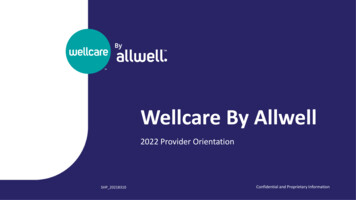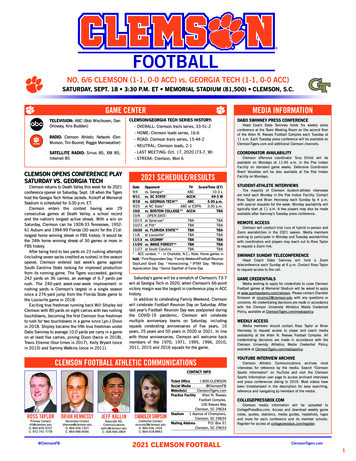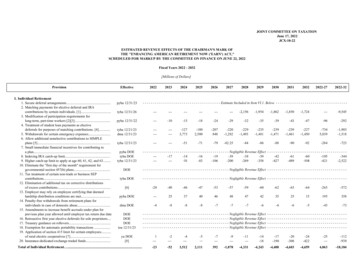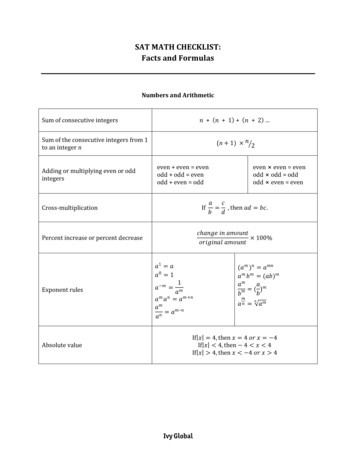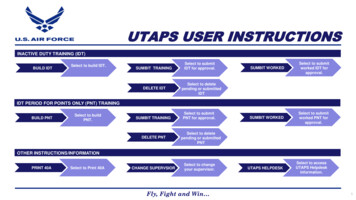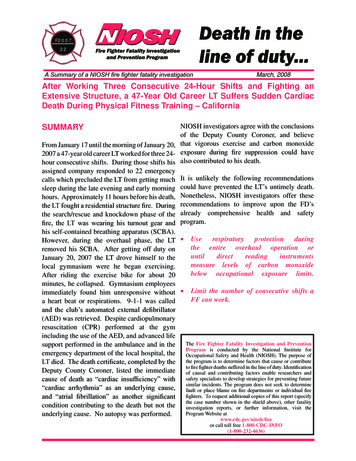
Transcription
F200722A Summary of a NIOSH fire fighter fatality investigationMarch, 2008After Working Three Consecutive 24-Hour Shifts and Fighting anExtensive Structure, a 47-Year Old Career LT Suffers Sudden CardiacDeath During Physical Fitness Training – CaliforniaNIOSH investigators agree with the conclusionsof the Deputy County Coroner, and believeFrom January 17 until the morning of January 20, that vigorous exercise and carbon monoxide2007 a 47-year old career LT worked for three 24- exposure during fire suppression could havehour consecutive shifts. During those shifts his also contributed to his death.assigned company responded to 22 emergencycalls which precluded the LT from getting much It is unlikely the following recommendationssleep during the late evening and early morning could have prevented the LT’s untimely death.hours. Approximately 11 hours before his death, Nonetheless, NIOSH investigators offer thesethe LT fought a residential structure fire. During recommendations to improve upon the FD’sthe search/rescue and knockdown phase of the already comprehensive health and safetyfire, the LT was wearing his turnout gear and program.his self-contained breathing apparatus (SCBA).respiratoryprotectionduringHowever, during the overhaul phase, the LT Usethe entire overhaul operation orremoved his SCBA. After getting off duty onuntildirectreadinginstrumentsJanuary 20, 2007 the LT drove himself to themeasure levels of carbon monoxidelocal gymnasium were he began exercising.below occupational exposure limits.After riding the exercise bike for about 20minutes, he collapsed. Gymnasium employeesimmediately found him unresponsive without Limit the number of consecutive shifts aFF can work.a heart beat or respirations. 9-1-1 was calledand the club’s automated external defibrillator(AED) was retrieved. Despite cardiopulmonaryresuscitation (CPR) performed at the gymincluding the use of the AED, and advanced lifeThe Fire Fighter Fatality Investigation and Preventionsupport performed in the ambulance and in theProgram is conducted by the National Institute foremergency department of the local hospital, theOccupational Safety and Health (NIOSH). The purpose ofLT died. The death certificate, completed by the the program is to determine factors that cause or contributeto fire fighter deaths suffered in the line of duty. IdentificationDeputy County Coroner, listed the immediate of causal and contributing factors enable researchers andcause of death as “cardiac insufficiency” with safety specialists to develop strategies for preventing futuresimilar incidents. The program does not seek to determine“cardiac arrhythmia” as an underlying cause, fault or place blame on fire departments or individual fireand “atrial fibrillation” as another significant fighters. To request additional copies of this report (specifythe case number shown in the shield above), other fatalitycondition contributing to the death but not theinvestigation reports, or further information, visit theProgram Website atunderlying cause. No autopsy was performed.SUMMARYwww.cdc.gov/niosh/fireor call toll free 1-800-CDC-INFO(1-800-232-4636)
2007Fatality Assessment and Control EvaluationInvestigative Report #F2007-22After Working Three Consecutive 24-Hour Shifts and Fighting an Extensive Structure Fire, a 47Year Old Career LT Suffers Sudden Cardiac Death during Physical Fitness Training – California Consider using coronary artery disease During the site visit NIOSH personnel reviewed(CAD) risk factors, rather than age the following documents related to thisalone, to determine the onset and incident: FD investigation file of the incidentfrequency of exercise stress tests. Discuss with local union representativesways to increase participation inthe FD’s fitness program and howto improve the wellness program.Perform an autopsy on all on-duty firefighter fatalities. Station 8 incident reports for January 17-20,2007FD incident report for the resuscitation effortDeath certificateCounty Sherriff / Coroner’s reportState of California, Doctor’s first report ofoccupational injury or illnessINVESTIGATIVE RESULTSINTRODUCTION & METHODSOn January 20, 2007, a 47-year-old male LTsuffered sudden cardiac death while performingphysical fitness training after working threeconsecutive shifts. On January 25, NIOSHwas notified of the fatality and, in February2007, contacted the affected FD to gatherinformation regarding the fatality. On August27, an occupational medicine physician fromthe NIOSH Fire Fighter Fatality Investigationand Prevention Team traveled to California toconduct an on-site investigation of the incident.During the investigation NIOSH personnel metwith or interviewed the following people: Page 2Fire ChiefFD Administrative Services ManagerSecretary/Treasurer of the local chapterof the International Association of FireFighters (IAFF)Crew members on-duty with the LTBattalion Chief on-duty with the LTFamily members of the LTOne of the LT’s personal physiciansOn January 17, 2007, at 0800 hours, the LTarrived at his fire station (Station 8) for a 24hour “overtime” shift (Shift A). Station 8 wasstaffed with eight fire fighters working oneladder truck and one engine. The LT was theofficer assigned to the engine. During the 24hour shift the LT and his engine crew respondedto 11 emergencies, including one structure fire,one mutual aid request, one smoke scare, andeight emergency medical service (EMS) calls.The engine was out of the station for 4½ hourswhile responding to these emergency callswhich occurred throughout the day, evening,night, and early morning hours of January 18,2007. At no point during this shift did the LTindicate to co-workers that he was having anyhealth problems.On January 18, at 0800 hours, the LT started hisregular shift (Shift B) at Station 8. Again, the LTwas the officer assigned to the engine along withthree other crewmembers. During this 24-hourshift, the engine responded to five emergenciesincluding two smoke/gas odors calls and threeEMS calls. The engine was out of the stationfor approximately 1-¾ hours while responding
2007Fatality Assessment and Control EvaluationInvestigative Report #F2007-22After Working Three Consecutive 24-Hour Shifts and Fighting an Extensive Structure Fire, a 47Year Old Career LT Suffers Sudden Cardiac Death during Physical Fitness Training – Californiathe LT searched each room, but did not findany occupants in the building after searchingfor about 10 minutes. He exited the structureand assisted with positioning an air blower atthe front door to increase ventilation of thestructure. The interior attack team found theThe LT had previously agreed to cover the “C” fire confined to the kitchen and proceeded withshift for the ladder truck officer, so on January extinguishment.19, at 0800 hours, the LT started his thirdconsecutive 24-hour shift. During this 24-hour Knockdown of the fire took approximately 20shift, the truck responded to six emergencies 30 minutes. Heat, smoke, and soot damage wasincluding two structure fires, two utility-related observed throughout the dwelling, but the firecalls, and two EMS calls. The ladder truck was damage was confined to the kitchen. At aboutout of the station for about 4-½ hours while 2245 hours overhaul began on the roof, but wasresponding to these emergencies; the majority delayed inside the house for about an hour forof the time (three hours) was spent responding the fire investigator’s inspection. During thisto the structure fire described below. The engine hour, the LT accompanied the fire investigatorfrom Station 8 responded to 17 emergencies throughout the house (wearing turnout gear butduring the same 24-hour period.not his self-contained breathing apparatus), andthen climbed into the attic and onto the roofAt 2212 hours, the ladder truck was dispatched to assist crewmembers overhauling the roof.to a house fire at a single family home of Overhaul operations ceased at approximatelyapproximately 1100 square feet. The air 0030 hours and units returned to quarters.temperature was approximately 50º Fahrenheitwith minimal wind. The ladder truck arrived at Station 8 crewmembers cleaned and re-stored2217 hours and noted smoke showing and active their equipment and then showered. Stationfire from the B side of the home with the front 8’s engine responded to emergency EMS callsdoor open. The LT assumed initial command throughout the early morning hours. At no pointof the incident and sent his crewmembers to during this shift did the LT complain or showventilate the roof. Station 8’s engine arrived a signs of any health problems.few seconds later, hooked up to the nearest waterhydrant, and positioned the engine at the front The LT left Station 8 at approximately 0800 hoursof the home as the crew prepared for interior and headed to the local gym. The LT exercisedattack. A few seconds later the Battalion Chief regularly (daily or at least every other day) asarrived and assumed command of the incident. part of the FD’s fitness and wellness program.During the three continuous 24-hour shiftsThe LT was re-assigned to conduct search and described above, the LT spent approximately 1rescue inside the structure with the interior hour each shift stretching and using the aerobicattack team. In full turnout gear and using air exercise equipment (treadmill and ellipticalfrom his self-contained breathing apparatus machine) in Station 8. At approximatelywhich weighed approximately 60-65 pounds, 0845 hours the LT began using the exerciseto these calls throughout the day, evening, nightand early morning hours of January 19, 2007.At no point during this second 24-hour shiftdid the LT express any signs or symptoms of ahealth problem.Page 3
2007Fatality Assessment and Control EvaluationInvestigative Report #F2007-22After Working Three Consecutive 24-Hour Shifts and Fighting an Extensive Structure Fire, a 47Year Old Career LT Suffers Sudden Cardiac Death during Physical Fitness Training – Californiabike. Witnesses described the LT as sweatingprofusely. He vomited, and collapsed off thebike at about 0910 hours. The gym staff notedhe was unresponsive without a pulse. 9-1-1 wascalled (0911 hours) as the gym staff placed anAED on the LT. Two shocks were deliveredwith no change in the LT’s clinical condition.The gym staff then initiated CPR.EMS units from the FD arrived at 0915 hoursand found the LT unresponsive with no pulse,no breathing, and CPR in progress. Oxygenwas initially provided by a bag-valve-maskwhile a cardiac monitor was attached. Themonitor showed a heart rhythm of “pulselesselectrical activity.” At 0919 hours paramedicssuccessfully placed a breathing tube into theLT’s airway (intubation) on the second attempt.Proper placement of the tube was confirmedby auscultation, esophageal detector device,and exhaled carbon dioxide detector deviceas recommended by the American HeartAssociation [AHA 2005]. An intravenous linewas established through which medicationsconsistent with advanced life support wereadministered.CPR continued until thetransporting ambulance company arrived at 0926hours. Despite CPR and advanced life supportperformed at the gym, in the ambulance, and inthe emergency department of the local hospital,the LT’s clinical condition did not improve.He was pronounced dead at 1009 hours andresuscitation efforts were discontinued.The death certificate, completed by the DeputyCounty Coroner, listed the immediate cause ofdeath as “cardiac insufficiency” with “cardiacarrhythmia” as an underlying cause, and “atrialfibrillation” as another significant contributingPage 4condition. No autopsy was performed. Accordingto the records available to NIOSH at the time ofthis report, no toxicology tests were performed(e.g., carboxyhemoglobin levels or drug screen).Medical Findings. The LT had a history ofatrial fibrillation first diagnosed in 1997 byan electrocardiogram (EKG) taken during theFD’s annual medical evaluation. He was takenoff-duty pending a cardiac evaluation. Thecardiologist performed an echocardiogramand an exercise stress test, both of which werereported as normal. The LT was prescribed onebaby aspirin per day and returned to full dutyfour days later.In 2001, atrial fibrillation was again noted byan EKG taken during the FD’s annual medicalevaluation. The LT was taken off-duty for twoweeks and eventually underwent direct currentcardioversion (shock) in September, 2001. From2001 to 2004, the LT was prescribed a numberof antiarrhythmic medications; in February 2004he underwent a surgical procedure known asablation to control his persistent atrial fibrillation.The LT was last seen by his personal cardiologistin November 2006. At the time of his death hewas taking flecainide, an antiarrhythmic andrate-limiting prescription medication.Medical records available to the NIOSHinvestigator at the time of this report suggestedthat the LT’s only risk factor for coronary arterydisease was obesity. He weighed 272 poundswith a height of 6 feet, giving him a bodymass index of 36.9 kilograms per meters2 (kg/m2) [CDC 2008]. Although a body mass indexof 30.0-39.9 kg/m2 generally is consideredobese, this method of determining obesity may
2007Fatality Assessment and Control EvaluationInvestigative Report #F2007-22After Working Three Consecutive 24-Hour Shifts and Fighting an Extensive Structure Fire, a 47Year Old Career LT Suffers Sudden Cardiac Death during Physical Fitness Training – Californiaoverestimate body fat in individuals with amuscular build [NHLBI 2008a]. DESCRIPTION OF THE FIREDEPARTMENT This FD consists of 586 uniformed personnelin 25 stations serving a population of 411,000residing within 52-square-miles. Operationalcomponents of the FD include: hazardousmaterials response, water rescue, heavy rescue,medical response, structural fire fighting,wildland fire fighting, shipboard fire fighting,aircraft rescue/fire fighting, and terrorism/weapons of mass destruction response. The FDtypically responds to about 60,000 emergencycalls each year, 80% of which are medicalemergencies. Complete medical and occupational historyHeight, weight, and vital signsPhysical examinationBlood tests: complete blood count, chemicalpanel (SMA 18), and lipid panelUrine drug screen (amphetamines, barbiturates,cocaine metabolites, marijuana metabolites,methadone, opiates, phyencyclidine, propoxyphene, and alcohol)Resting EKG (12 lead)Chest X-ray (one posterior-anterior view)Pulmonary function testsAudiogramVision titmus testTuberculin skin testHepatitis B and C antibody screening testsOnce this evaluation is complete, the physicianmakes a determination regarding medicalclearance for fire fighting duties and forwardsthis decision to the FD’s personnel director. TheLT joined the FD in 1990. At the time of his deathTo become a fire fighter within this FD, applicants he had 16 years of fire fighting experience.must complete an application, pass a writtenexamination, pass two interviews by panels Annual Medical Evaluation. Every fire fighterof FD and municipal officials, pass a physical has an annual medical evaluation by the sameability test (Appendix A), pass a background contract physicians group conducting the postcheck, pass a psychological evaluation, and be offer / pre-placement medical evaluation. Themedically cleared for duty (described below) components of the annual evaluation are thebefore being accepted into the recruit class. The same as the post-offer / preplacement evaluationrecruit class must complete the 16 week Fire except that chest x-rays are not done unlessAcademy administered by the FD. After passing clinically indicated, and an exercise stress testthe Fire Academy, the fire fighter is assigned to (e.g., a treadmill) test is done for fire fightersa fire station as a probationary employee. After over the age of 40 every other year. Once thistwelve months of satisfactory performance as a evaluation is complete, the physician makesprobationary employee, the fire fighter becomes a determination regarding medical clearancea member of the FD.for fire fighting duties and respirator use, thenforwards this decision to the FD’s personnelPost-offer/Pre-placement Medical Evaluation.The FD requires a post-offer/pre-placementmedical evaluation conducted by a physiciangroup under contract with the FD. Components ofthis medical evaluation include the following:Page 5
2007Fatality Assessment and Control EvaluationInvestigative Report #F2007-22After Working Three Consecutive 24-Hour Shifts and Fighting an Extensive Structure Fire, a 47Year Old Career LT Suffers Sudden Cardiac Death during Physical Fitness Training – Californiadirector. The LT was evaluated in 2006 andcleared for fire fighting duties, but, at the time ofthis report, the NIOSH investigator did not haveaccess to the LT’s exercise stress tests results.Health/Wellness. As mentioned earlier, the FDrequires candidates to pass a physical abilitytest, and requires the same test for members.The FD provides exercise equipment (strengthand aerobic) in all their fire stations and allowsfire fighters to exercise for about 1½ hourswhile on-duty. However, use of the equipmentis voluntary, and the Fire Chief estimates thatabout 40% of fire fighters exercise while onduty. According to his crewmembers, the LTexercised regularly while on-duty, typicallyusing the treadmill and elliptical machineseach shift. Wellness education is provided bythe contract physicians group conducting themedical evaluation, however some of the firefighters mentioned the scope of the effort couldbe improved.DISCUSSIONAtrial FibrillationDefinition - Atrial fibrillation is a disturbanceof the heart’s conduction system. Duringatrial fibrillation, the heart’s two small upperchambers (the atria) beat very rapidly in a nonproductive, quivering manner. The heart’s AVnode blocks many of the atrium’s electricalsignals from traveling to the heart’s ventricles.However, enough electrical signals get throughthe AV node to result in a rapid and irregularheart beat described by many patients aspalpitations [Waktare 2002]. Other symptomsassociated with atrial fibrillation include fatigueand lethargy.Page 6Atrial fibrillation can occur in three differentpatterns: paroxysmal, persistent, or permanent.Paroxysmal atrial fibrillation occurs inepisodes lasting seconds to days, and resolvespontaneously.Persistent atrial fibrillationdoes not stop spontaneously. Permanent atrialfibrillation describes the condition when theheart’s normal sinus rhythm cannot be restoreddespite treatment.Treatment - There are three major treatmentconsiderations for atrial fibrillation.Thefirst involves returning the heart to a normal(sinus) rhythm by prescribing antiarrhythmicmedications (e.g., flecainide, amiodarone,etc.), or administering a shock (direct currentcardioversion). If these efforts fail to restoresinus rhythm, other treatments may includeablation surgery (selective elimination of one ormore sites in the atria to reduce the recurrenceof atrial fibrillation) and/or the placement of acardiac pacemaker [Oral 2006; Ames 2006].The second treatment consideration involvesreducing the number of impulses transmittedthrough the AV node by prescribing “ratelimiting” medications (e.g. digoxin, betablockers, etc.). The third treatment considerationinvolves preventing blood clots thereby reducingthe risk of stroke. The risk of blood clots can bereduced by prescribing anticoagulant drugs (i.e.,coumadin) or anti-platelet drugs (i.e., aspirin).Risk Factors - Atrial fibrillation has beenassociated with caffeine use, alcohol use,hyperthyroidism, and obesity, but by far themost important and strongest risk factors are thepresence of other heart conditions [Wang 2004;Frost 2005; Fuster 2006]. These predisposingheart conditions include coronary artery disease(CAD), heart valve problems, heart failure, left
2007Fatality Assessment and Control EvaluationInvestigative Report #F2007-22After Working Three Consecutive 24-Hour Shifts and Fighting an Extensive Structure Fire, a 47Year Old Career LT Suffers Sudden Cardiac Death during Physical Fitness Training – Californiaatrial enlargement, and hypertension. Whenyounger patients (less than age 60) are diagnosedwith atrial fibrillation, between 20-45% haveno associated predisposing cardiac conditions[Levy 1999]. There has been one reportedcase of atrial fibrillation associated with acuteexposure to fire smoke [Bass 1979].ablation and was placed on restricted duty.Heart rhythm tracings over the next two monthsshowed that the ablation surgery reduced, butdid not eliminate, the atrial fibrillation. Thepartial success of the ablation allowed the LTto discontinue his anticoagulant medication andreturn to full duty.Prognosis - The prognosis for persons withatrial fibrillation depends on a number of factorsincluding the type of atrial fibrillation and thepresence of predisposing conditions. Strokeis the most common and one of the seriouscomplications. Atrial fibrillation patients withan underlying heart valve problem have a 17fold increased risk of a stroke [Fuster 2006].However, in young patients without any of thepredisposing factors listed above or diabetesmellitus, the risk of stroke is estimated to be1% and only aspirin is recommended for strokeprevention [Fuster 2006].Sudden Cardiac Death. Most cases of suddencardiac death are related to coronary heart diseaseand/or a heart attack (myocardial infarction).Establishing the occurrence of a heart attackrequires any of the following: characteristicEKG changes, elevated cardiac enzymes, orcoronary artery thrombus. In the LT’s case,he never regained a heart rhythm on whichan EKG could reveal characteristic changes,cardiac enzyme testing was not performed (butwe would not expect the enzymes to becomepositive for at least 4 hours post-heart attack),and no autopsy was performed to find a coronaryartery thrombus [AHA 2008a]. In the setting of aAs mentioned earlier in this report, the LT was heart attack (acute myocardial infarction), atrialfirst diagnosed with atrial fibrillation in 1997 by fibrillation increases the risk of sudden cardiacan EKG taken during the FD’s annual medical death [Gronefeld 2000; Pedersen 2006].evaluation. He was asymptomatic at this time.Subsequent cardiac evaluation revealed no Although a heart attack was possible, NIOSHunderlying heart conditions. Given his age (38 investigators consider this unlikely given the LTyears old) and lack of heart problems, NIOSH only had two (male gender and obesity) of theinvestigators agree with the decision to return many risk factors for CAD [AHA 2008b]. In thethe LT to full duty on one baby aspirin per day absence of a heart attack or other predisposing(anti-platelet medication).cardiac conditions, atrial fibrillation, by itself,is not associated with sudden cardiac deathThe LT’s asymptomatic paroxysmal atrial [Hagens 2006]. Since the LT probably did notfibrillation developed into persistent atrial have a heart attack and did not have any of thefibrillation with fatigue and lethargy. From 2001 predisposing cardiac conditions, why did the LTto 2004, the LT tried direct current cardioversion, suffer sudden cardiac death?and the use of anti-arrhythmic and rate-limitingmedications. In 2004 he underwent surgicalPage 7
2007Fatality Assessment and Control EvaluationInvestigative Report #F2007-22After Working Three Consecutive 24-Hour Shifts and Fighting an Extensive Structure Fire, a 47Year Old Career LT Suffers Sudden Cardiac Death during Physical Fitness Training – Californiaare present in fire smoke, not only during theknockdown phase, but also during overhaul[Bolstad-Johnson 2000]. Carbon monoxide hasbeen reported to exacerbate CAD, trigger heartattacks, increase ventricular arrhythmias, andlower the threshold for ventricular fibrillation[DeBias 1976; Atkins 1986; Marius-Nunez1990; Sheps 1990]. Because the LT’s bloodwas not tested for evidence of carbon monoxidepoisoning, it is not possible to assess whether suchexposure was a factor in his death. However, ifcarbon monoxide poisoning played a role in theLT’s death, he should have collapsed shortlyAnother possible explanation for the LT’s after his exposure on the fire ground, rather thansudden death is a complication from his atrial 9 hours later.fibrillation or its treatment. For example,stroke is a common complication and has been The LT died during fitness training. Epidemiologicassociated with sudden death [Phillips 1977]. studies in the general population have found thatAlthough an autopsy would have been able to heavy physical exertion can trigger a heart attackrule out this complication, NIOSH investigators and cause sudden cardiac death [Tofler 1992;consider this unlikely due to the accounts of Willich 1993; Mittleman 1993; Albert 2000].how the LT collapsed.Epidemiologic studies among fire fighters haveshown that fire suppression, training, alarmAnother complication of atrial fibrillation response, and strenuous physical activity on thecould be a side effect of flecainide, the LT’s increased the risk for a sudden cardiac eventantiarrhythmic medication. Flecainide has been [Kales 2003; Hales 2007a; Kales 2007]. The LTreported to increase the risk of some ventricular was involved in heavy physical activity duringarrhythmias (ventricular proarrhythmias) and fire suppression 11 hours prior to his death, andconvert atrial fibrillation to atrial flutter with involved in strenuous physical exertion duringrapid conduction through the AV node, both of his fitness training.which could cause sudden cardiac death [VanGelder 1989; Fuster 2006]. However, the LT Based on the findings discussed above, thedid not have any of the factors predisposing to NIOSH investigator concluded that the LT dieddrug-induced ventricular proarrhythmias, and from a cardiac arrhythmia due to a combinationthis side effect is relatively rare [Fuster 2006]. of his underlying cardiac conduction abnormality,heavy physical exertion and possible exposureEleven hours prior to his death the LT was to carbon monoxide during fire suppressioninvolved in fire suppression and exposed to fire and heavy physical exercise during this fitnesssmoke during overhaul without the protection training program.of his SCBA. High levels of carbon monoxideOne possibility is the presence of an “accessorypathway” in the atrium’s conduction system(e.g., Wolf-Parkinson-White syndrome). Thisaccessory pathway can allow the very fastelectrical signals in atrial fibrillation to bypassthe AV node, resulting in rapid ventricularrates that can degenerate into lethal ventricularfibrillation [Fuster 2006]. Although possible,NIOSH investigators consider the presence ofan accessory pathway unlikely because the LThad no suggestion of such a pathway on EKG ornoted during the ablation surgery.Page 8
2007Fatality Assessment and Control EvaluationInvestigative Report #F2007-22After Working Three Consecutive 24-Hour Shifts and Fighting an Extensive Structure Fire, a 47Year Old Career LT Suffers Sudden Cardiac Death during Physical Fitness Training – CaliforniaRECOMMENDATIONSIt is unlikely the following recommendationscould have prevented the LT’s untimely death.Nonetheless, NIOSH investigators offer theserecommendations to improve upon the FD’salready comprehensive health and safetyprogram.Recommendation #1: Use respiratory protectionduring the entire overhaul operation or untildirect reading instruments measure levels ofcarbon monoxide below occupational exposurelimits.Overhaul fire smoke contains a number ofhazardous substances including irritants,asphyxiates (e.g., carbon monoxide, cyanide,etc.) and several probable/possible humancarcinogens (e.g., formaldehyde, benzene, etc.)[Jankovic 1991; Kinnes 1998; Bolstad-Johnson2000; Austin 2001]. Because of the variety oftoxins present in overhaul fire smoke, completerespiratory protection requires the continuoususe of an SCBA. However, the continuous useof an SCBA over a long period of time increasesthe risk of fire fighter fatigue, overexertion, heatstress, and injuries. In addition, refilling emptycylinders (bottles) presents logical problemsduring extensive overhaul operations.Ideally, a direct reading instrument couldinstantaneously measure all the hazardouscomponents of fire smoke. When all measurementsreach safe or non-detectible levels, fire fighterscould safely doff their SCBA. Unfortunately,such an instrument does not exist. Therefore,some FDs require SCBA use during overhauluntil direct reading instruments measure carbonmonoxide concentrations 50 or 35 parts permillion (ppm) [Kinnes 1998; Cook 2006; Hales2007b]. However, low concentrations of carbonmonoxide do not always correlate with lowconcentrations of the other constituents of firesmoke during overhaul [Bolstad-Johnson 2000].This had led some to recommend continuousSCBA use, or SCBA use until carbon monoxideconcentrations are 150 ppm, then requirethe use of air purifying respirators equippedwith cartridges appropriate for particulates,aldehydes, acid gases, and organic vapor untiloverhaul is complete [Bolstad-Johnson 2000;Carter 2001].Recommendation #2: Limit the number ofconsecutive shifts a FF can work.In 2004, NIOSH reviewed the literature on thehealth effects of overtime and extended workshifts (typically 12-hour shifts compared to8-hour shifts). Overtime was associated withpoorer perceived general health, increasedinjury rates, more illnesses, or increasedmortality in 16 of 22 studies reviewed [NIOSH2004]. Extended work shifts were associatedwith decreased alertness, increased fatigue,lower cognitive function, declines in vigilance,and increased injuries [NIOSH 2004]. Studiesamong physicians who worked very long shifts( 24 hours) reported deteriorating cognitiveperformance, more frequent patient errors, andmore frequent motor vehicle accidents aftertheir shift [NIOSH 2004; Barger 2005, Barger2006].Prior to his death, the LT worked three consecutive24-hour shifts. While the LT was able to
from january 17 until the morning of january 20, 2007 a 47-year old career lt worked for three 24-hour consecutive shifts. during those shifts his assigned company responded to 22 emergency calls which precluded the lt from getting much sleep during the late evening and early morning hours. approximately 11 hours before his death, the lt
